ASRock Fatal1ty Z77 Professional Review - IDE and Floppy on Z77
by Ian Cutress on May 20, 2012 1:30 PM EST- Posted in
- Motherboards
- ASRock
- Fatal1ty
- Z77
Test Setup
| Processor |
Intel Core i7-3770K ES 4 Cores, 8 Threads, 3.5 GHz (3.9 GHz Turbo) |
| Motherboards |
ASRock Z77 Extreme4 ASUS P8Z77-V Pro Gigabyte GA-Z77X-UD3H MSI Z77A-GD65 ASUS P8Z77-V Deluxe ASRock Fatal1ty Z77 Professional |
| Cooling | Intel All-in-One Liquid Cooler |
| Power Supply | OCZ 1250W Gold ZX Series |
| Memory |
GSkill RipjawsZ 4x4 GB DDR3-2400 9-11-11 Kit GSkill TridentX 2x4 GB DDR3-2666 11-13-13 Kit |
| Memory Settings | XMP (2400 9-11-11) |
| Video Cards |
ASUS HD7970 3GB ECS GTX 580 1536MB |
| Video Drivers |
Catalyst 12.3 NVIDIA Drivers 296.10 WHQL |
| Hard Drive | Micron RealSSD C300 256GB |
| Optical Drive | LG GH22NS50 |
| Case | Open Test Bed - CoolerMaster Lab V1.0 |
| Operating System | Windows 7 64-bit |
| SATA Testing | Micron RealSSD C300 256GB |
| USB 2/3 Testing | OCZ Vertex 3 240GB with SATA->USB Adaptor |
Power Consumption
Power consumption was tested on the system as a whole with a wall meter connected to the OCZ 1250W power supply, while in a dual 7970 GPU configuration. This power supply is Gold rated, and as I am in the UK on a 230-240 V supply, leads to ~75% efficiency > 50W, and 90%+ efficiency at 250W, which is suitable for both idle and multi-GPU loading. This method of power reading allows us to compare the power management of the UEFI and the board to supply components with power under load, and includes typical PSU losses due to efficiency. These are the real world values that consumers may expect from a typical system (minus the monitor) using this motherboard.
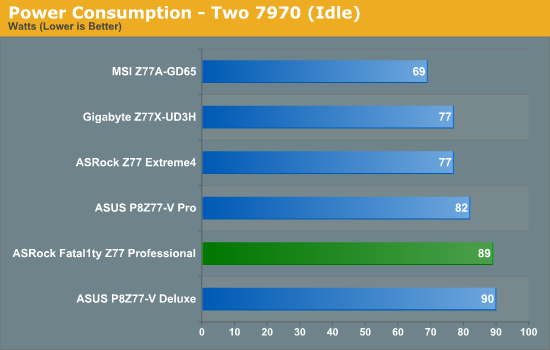
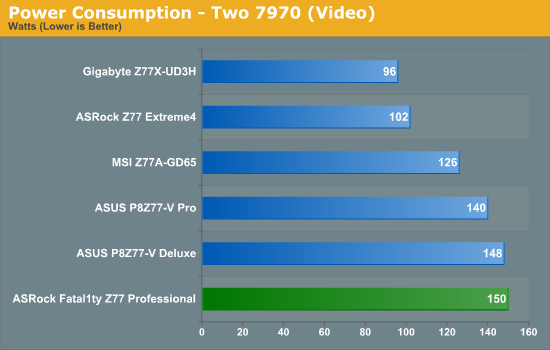
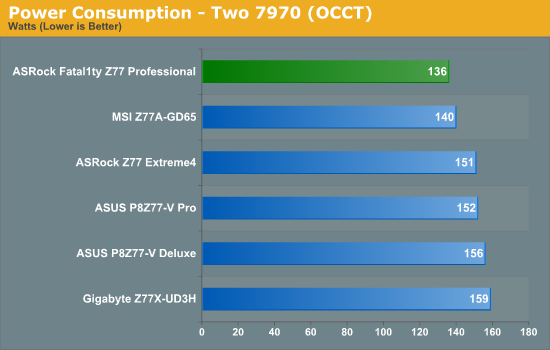
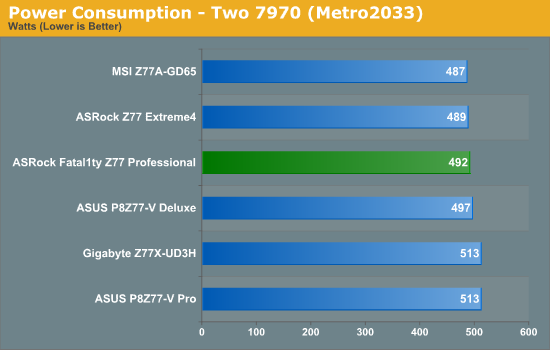
A trend I have noticed over the course of Ivy Bridge testing is that the more power phases there are on a board, the more of the phases are ‘loaded’ during moderate CPU usage, such as playing video. As these phases are at low loading individually, they are relatively inefficient than compared to high loading – this leads to a lot of power draw. As the ASRock Fatal1ty Z77 Professional has a 16+8 phase power delivery, we see this explicitly with 150W system power draw at load – 48W more than the ASRock Z77 Extreme4. There could also be other reasons for this difference, such as different signals to the GPUs regarding power required and how they power gate certain features.
POST Time
Different motherboards have different POST sequences before an operating system is initialized. A lot of this is dependent on the board itself, and POST boot time is determined by the controllers on board (and the sequence of how those extras are organized). As part of our testing, we are now going to look at the POST Boot Time - this is the time from pressing the ON button on the computer to when Windows starts loading. (We discount Windows loading as it is highly variable given Windows specific features.) These results are subject to human error, so please allow +/- 1 second in these results. As requested in my initial Z77 review, we will also be showcasing normal and ‘stripped’ POST times, whereby controllers are turned off in an attempt to get the minimum POST time.
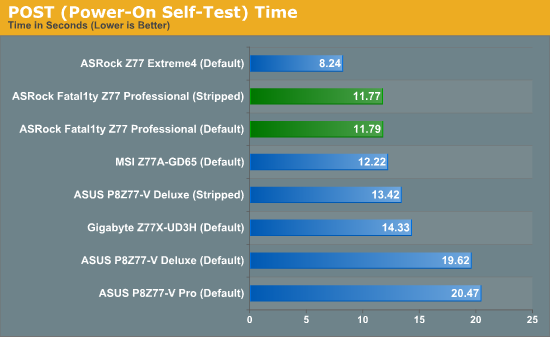
Overall, ASRock are posting some rather reasonable POST times, coming in at almost half the time of the slowest boards. It seems that the controllers on board have little effect on the POST time itself, as the stripped time comes in almost exactly the same as the default time.
Overclocks
Here at AnandTech we want to provide quick and easy ways to determine if a board is good for you (with in-depth analysis of course). So here is a quick round up of our overclocking results. Overclocks are tested for stability with PovRay and OCCT - while these may not be the most strenuous of stability tests, it does offer a quick check for memory errors under high load (and also balances testing time with getting the next board on for review!).
|
CPU Speed (MHz) |
Voltage (Volts) |
PovRay Peak Temp (ºC) |
OCCT Peak Temp (ºC) |
Notes | |
|
ASRock Fatal1ty Z77 Professional |
4700 | 1.200 | 89 | 89 | PLL Overvoltage enabled |
|
ASRock Z77 Extreme4 |
4700 | 1.175 | 86 | 86 | LLC Level 1 |
|
ASUS P8Z77-V Deluxe |
4700 | 1.225 | 89 | 84 | PLL Overvoltage enabled |
|
ASUS P8Z77-V Pro |
4700 | 1.200 | 83 | 86 | PLL Overvoltage enabled |
|
Gigabyte Z77X-UD3H |
4700 | 1.200 | 82 | 86 | LLC Extreme |
|
MSI Z77A-GD65 |
4700 | 1.250 | 90 | - | PLL Overvoltage enabled |










57 Comments
View All Comments
Chaitanya - Sunday, May 20, 2012 - link
I am wondering how many people actually use floppy drive in this day and age when OS can install RAID drivers off a USB thumb drive and motherboards can flash bios even without having a CPU installed.shabby - Sunday, May 20, 2012 - link
How else will people make floppy music? https://www.youtube.com/watch?v=LgfPYetWWJwNow wheres my printer port!
SlyNine - Sunday, May 20, 2012 - link
Thanks man, made my day!MonkeyPaw - Sunday, May 20, 2012 - link
That is awesome. Seems like something at the end of a Portal game.anirudhs - Sunday, May 20, 2012 - link
There used to be a time when booting into Linux was only possible using a floppy drive.CharonPDX - Thursday, May 24, 2012 - link
There used to be a time when booting into *ANY* OS was only possible using a floppy drive.Heck, Windows XP required a floppy drive to load storage drivers if you weren't using a supported storage controller. (Which could be worked around if you were really dedicated, but for the average home user...)
But since Windows Vista, we have no legitimate reason for the floppy drive to be internal as opposed to USB.
Many motherboard makers have a "legacy" motherboard available, that includes these things (plus serial and parallel ports,) for those customers that truly need them. But a gamer doesn't. I haven't *NEEDED* a floppy drive since at least 2006. Yes, I've *USED* one since, but a USB one works just fine for everything I've needed to use it for. Nearly the same for PATA. I can't think of any gamer that still has an PATA drive sitting around that they just *NEED* to use. Yeah, digging data off an old retired PATA drive is nice, but there are (SHOCK!) USB-to-PATA adapters that work just fine. (And since the absolute fastest PATA drives are barely equal to USB 2.0, the speed "hit" doesn't matter.)
I have a vintage computer collection, and use PATA, SCSI, even ESDI hard drives; along with 1.44 MB floppies, and even all the way back to 5.25" single-sided floppies, on a regular basis.
But I don't need support for any of them in my gaming PC. (Then again, I also bought the Abit AT7-MAX motherboard when it first came out, lacking PS/2, serial, and parallel ports when leaving them off was controversial. So maybe I'm just someone who is perfectly happy to ditch legacy on modern gear before others.)
It would be one thing if most boards still had them, but they don't. I don't even get the inclusion of the PS/2 port on many "gaming" boards these days. Does anyone still use a PS/2 keyboard or mouse on their modern "gaming" system? Haven't all gamers moved on to new fancy laser mice? (Or whatever the fad-of-the-minute is.)
DanNeely - Sunday, May 20, 2012 - link
when all the previous generation of boards yanked pata/floppy support there were enough people sending protest letters to convince most of the mobo makers to add it back for at least a few models.Personally I suspect they would've been better off jointly designing a pata/floppy pcie 1x card for the legacy device brigade.
Lazlo Panaflex - Monday, May 21, 2012 - link
Asrock has included IDE and floppy connectors in various boards since the Dual-VSTA days...this is nothing new. Plus, some people still have decent IDE stuff laying around (i.e. DVD burners). Some older versions of Ghost run off a floppy.SlyNine - Sunday, May 20, 2012 - link
The reason I bought the board was because AsRocks name is a much better commodity then it was back in the A64 days. I bought it because I AsRocks name had proven itself, and I needed a motherboard with a hella lot of HDD ports. This build has been on 24/7 and up for weeks at a time before rebooting for 6 months so I'm glad I got the motherboard afterall. All the Fatality 1 did was make me not want it. But again needed the 10 HDD ports.I don't care about the Fatality 1 on the board at all. Used to play a ton of FPS's and I'm very very good at them. To bad I moved to a place with crappy internet, and was forced to buy a LCD. Makes all the difference in the world!
AssBall - Monday, May 21, 2012 - link
So you moved somewhere with crappy internet and need 10 drives spinning all the time on an ATX board... because that's not pointless, inefficient, or unrealistic at all....